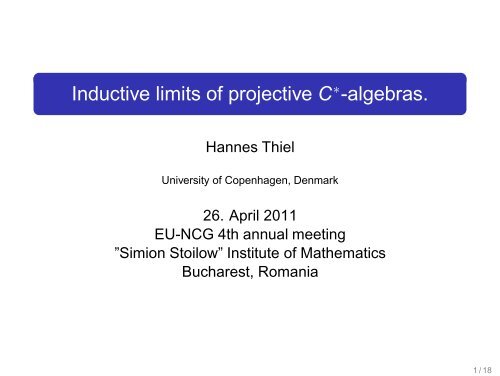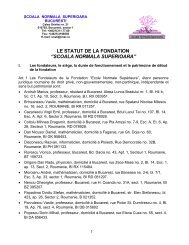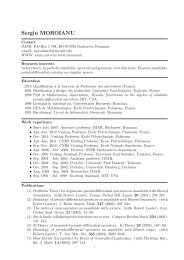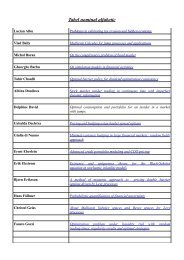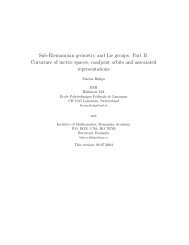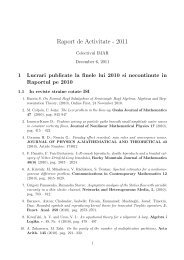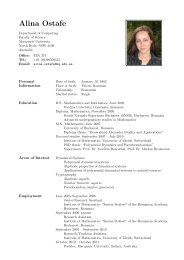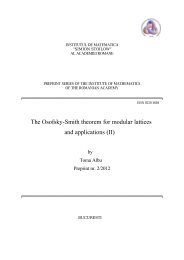Inductive limits of projective C*-algebras. - IMAR
Inductive limits of projective C*-algebras. - IMAR
Inductive limits of projective C*-algebras. - IMAR
You also want an ePaper? Increase the reach of your titles
YUMPU automatically turns print PDFs into web optimized ePapers that Google loves.
<strong>Inductive</strong> <strong>limits</strong> <strong>of</strong> <strong>projective</strong> C ∗ -<strong>algebras</strong>.<br />
Hannes Thiel<br />
University <strong>of</strong> Copenhagen, Denmark<br />
26. April 2011<br />
EU-NCG 4th annual meeting<br />
”Simion Stoilow” Institute <strong>of</strong> Mathematics<br />
Bucharest, Romania<br />
1 / 18
Introduction I<br />
Shape theory:<br />
a tool to study global properties <strong>of</strong> spaces<br />
better than homotopy theory if a space has singularities<br />
Idea:<br />
approximate a space by nicer spaces (building blocks)<br />
study approximating system instead <strong>of</strong> original space<br />
object:<br />
building<br />
blocks:<br />
approximation:<br />
commutative world noncommutative world<br />
metric space X separable C ∗ -algebra A<br />
absolute neighborhood<br />
retracts X k<br />
semi<strong>projective</strong><br />
C ∗ -<strong>algebras</strong> A k<br />
limit (= inverse limit) colimit (=inductive limit)<br />
X ∼ = lim ←− (... → X2 → X1} A ∼ = lim<br />
−→ (A1 → A2 → ...}<br />
2 / 18
Introduction II<br />
problem: Are there enough building blocks in order to<br />
approximate every space?<br />
commutative world: Yes.<br />
(every metric spaces is an inverse limit <strong>of</strong> ANRs)<br />
noncommutative world: We don’t know.<br />
Question 1.1 (Blackadar)<br />
Which C ∗ -<strong>algebras</strong> are inductive <strong>limits</strong> <strong>of</strong> semi<strong>projective</strong>s?<br />
Theorem 1.2 (Sørensen, T)<br />
C(X) is semi<strong>projective</strong> ⇔ X is an ANR with dim(X) ≤ 1.<br />
Theorem 1.3 (Loring, Shulman)<br />
For every C ∗ -algebra A, the cone CA = C0((0, 1])⊗A is an<br />
inductive limit <strong>of</strong> <strong>projective</strong> C ∗ -<strong>algebras</strong>.<br />
3 / 18
Noncommutative shape theory I<br />
Blackadar developed noncommutative shape theory for all<br />
separable C ∗ -<strong>algebras</strong><br />
to avoid possible problems with too few building blocks,<br />
change notion <strong>of</strong> approximation:<br />
Definition 2.1<br />
A morphism ϕ: A → B is called (weakly) semi<strong>projective</strong>,<br />
abbreviated by (W)SP, if:<br />
∀ C with increasing sequence <strong>of</strong><br />
ideals J1 ✁ J2 ✁...✁C,<br />
σ: B → C/ <br />
k Jk (and ε > 0 and<br />
finite subset F ⊂ A)<br />
∃ k and ψ: A → C/Jk such that<br />
the diagram commutes (up to ε<br />
on F ):<br />
A ϕ<br />
ψ<br />
C<br />
C/J k<br />
B σ C/ <br />
k Jk<br />
4 / 18
Noncommutative shape theory II<br />
Definition 2.2<br />
If in the above definition, there is always a lift σ: A → C, then<br />
the morphism is called (weakly) <strong>projective</strong>.<br />
A C ∗ -algebra A is called (weakly) (semi-)<strong>projective</strong>, if the<br />
morphisms id A: A → A is.<br />
A semi<strong>projective</strong>:<br />
A σ<br />
ψ<br />
C/Jk<br />
C/ <br />
k Jk<br />
Theorem 2.3 (Blackadar)<br />
A <strong>projective</strong>:<br />
ψ<br />
A σ<br />
C<br />
C/J<br />
Every C ∗ -<strong>algebras</strong> is the inductive limit <strong>of</strong> an inductive system<br />
with semi<strong>projective</strong> connecting maps. Such a system is called<br />
shape system.<br />
5 / 18
Noncommutative shape theory III<br />
Definition 2.4<br />
A and B are shape equivalent, denoted A ∼ Sh B, if they have<br />
shape systems with intertwinings that make the following<br />
diagram commute up to homotopy:<br />
A1<br />
α1<br />
γ1<br />
B1<br />
β1<br />
A2<br />
θ1<br />
α2<br />
γ2<br />
B2<br />
β2<br />
A3 ... A<br />
If only upper triangles commute, say A is homotopy<br />
dominated by B, denoted A Sh B.<br />
Remark 2.5<br />
Shape theory extends homotopy theory:<br />
A ≃ B ⇒ A ∼ Sh B; A B ⇒ A Sh B<br />
converses hold if A, B are SP<br />
... B<br />
6 / 18
Noncommutative shape theory IV<br />
For X a compact, connected, metric space, and x ∈ X, set:<br />
Example 2.6 (Dadarlat)<br />
C0(X0) := C0(X \{x})<br />
If X, Y are compact, connected, metric spaces, then:<br />
C0(X0) ∼ Sh C0(Y0) ⇔ (X, x) ∼ Sh (Y, y)<br />
This means: noncommutative shape theory = classical shape<br />
theory for commutative C ∗ -<strong>algebras</strong>. However:<br />
C0(X0)⊗K ∼ Sh C0(Y0)⊗K ⇔ K ∗ (X, x) ∼ = K ∗ (Y, y)<br />
7 / 18
<strong>Inductive</strong> <strong>limits</strong> <strong>of</strong> <strong>projective</strong> C ∗ -<strong>algebras</strong> I<br />
Need criterion to decompose a C∗-algebra as inductive limit.<br />
For example: Given A = lim Ak and Ak = lim A<br />
−→ −→l l k . When is A an<br />
inductive limit <strong>of</strong> some <strong>algebras</strong> Al k ?<br />
Theorem (Dadarlat, Eilers: AAH = AH)<br />
There exists A = lim<br />
−→ Ak such that each Ak is AH (an inductive<br />
limit <strong>of</strong> homogeneous <strong>algebras</strong>), but A is not AH.<br />
Proposition 3.1 (T)<br />
A = lim Ak, each Ak = lim A<br />
−→ −→l l k inductive limit <strong>of</strong> f.g. WSP<br />
<strong>algebras</strong> Al k ⇒ A is inductive limit <strong>of</strong> some <strong>algebras</strong> Al k .<br />
Notation<br />
AP := class <strong>of</strong> inductive <strong>limits</strong> <strong>of</strong> f.g. <strong>projective</strong> <strong>algebras</strong><br />
Theorem 3.2 (Loring, Shulman)<br />
A is f.g. ⇒ the cone CA = C0((0, 1])⊗A lies in AP<br />
8 / 18
<strong>Inductive</strong> <strong>limits</strong> <strong>of</strong> <strong>projective</strong> C ∗ -<strong>algebras</strong> II<br />
Theorem 3.3 (T)<br />
Let A be a C ∗ -algebra. Then the following are equivalent:<br />
1 A lies in AP<br />
2 A ∼ Sh 0 (A has trivial shape)<br />
3 A is inductive limit <strong>of</strong> (f.g.) cones<br />
4 A is inductive limit <strong>of</strong> (f.g.) contractible C ∗ -<strong>algebras</strong><br />
Remark 3.4<br />
This generalizes Loring, Shulman, since C0((0, 1])⊗A ≃ 0<br />
Corollary 3.5 (Closure properties <strong>of</strong> AP)<br />
AP is closed under countable direct sums, inductive <strong>limits</strong>,<br />
approximation by sub-C ∗ -<strong>algebras</strong> and maximal tensor<br />
products with any other C ∗ -algebra,<br />
i.e., A⊗max B ∈ AP as soon as A ∈ AP<br />
9 / 18
<strong>Inductive</strong> <strong>limits</strong> <strong>of</strong> <strong>projective</strong> C ∗ -<strong>algebras</strong> III<br />
sketch <strong>of</strong> pro<strong>of</strong>.<br />
”(2)⇒(1)”: A ∼ Sh 0 means:<br />
A1<br />
γ1<br />
A2<br />
γ2<br />
... A<br />
0 0 ... 0<br />
⇒ γ k ≃ 0, which corresponds naturally to a morphism<br />
Γ k: A k → CA k+1 such that γ k = ev1◦Γ k<br />
A1<br />
Γ1<br />
γ1<br />
CA2<br />
ev1<br />
A2<br />
Γ2<br />
γ2<br />
... A = lim<br />
−→ A k<br />
CA3 ... A = lim<br />
−→ CA k<br />
each CA k ∈ AP ⇒ A ∈ AP [by criterion for inductive limit]<br />
∼=<br />
∼=<br />
10 / 18
<strong>Inductive</strong> <strong>limits</strong> <strong>of</strong> <strong>projective</strong> C ∗ -<strong>algebras</strong> IV<br />
Corollary 3.6<br />
Every contractible C ∗ -algebra is an inductive limit <strong>of</strong> <strong>projective</strong><br />
C ∗ -<strong>algebras</strong>.<br />
Remark 3.7<br />
This is the non-commutative analogue <strong>of</strong> the following classical<br />
result: Every contractible space is an inverse limit <strong>of</strong> ARs.<br />
Example 3.8<br />
X := {0}×[−1, 1]∪{(x, sin(1/x)) ∈ R 2 | 0 < x ≤ 1/π}<br />
X0 := X \{(1/π, 0)}<br />
Then C0(X0) ∼ Sh 0, while C0(X0) ≃ 0.<br />
For every algebra A, C0(X0, A) is inductive limit <strong>of</strong> <strong>projective</strong>s.<br />
11 / 18
<strong>Inductive</strong> <strong>limits</strong> <strong>of</strong> <strong>projective</strong> C ∗ -<strong>algebras</strong> V<br />
Example 3.9 (Dadarlat)<br />
There exists a commutative C ∗ -algebra A = C0(X, x0) such that<br />
A⊗K ≃ 0 (in particular A⊗K ∼ Sh 0), while A ≁ Sh 0.<br />
Corollary 3.10<br />
Trivial shape does not pass to full hereditary sub-C ∗ -<strong>algebras</strong>.<br />
Proposition 3.11 (T)<br />
Let (Ak,γk) be an inductive system. Then there exists an<br />
inductive system (Bk,δK) with surjective connecting morphisms<br />
and such that lim Ak −→ ∼ = lim Bk.<br />
−→<br />
Moreover, we may assume Bk = Ak ∗F∞, where<br />
F∞ := C∗ (x1, x2,... |x i ≤ 1) is the universal C∗-algebra generated by a countable number <strong>of</strong> contractive generators.<br />
If Ak is (semi-)<strong>projective</strong>, then so is Ak ∗F∞.<br />
12 / 18
<strong>Inductive</strong> <strong>limits</strong> <strong>of</strong> <strong>projective</strong> C ∗ -<strong>algebras</strong> VI<br />
Corollary 3.12<br />
A ∼ Sh 0 ⇒ A is inductive limit <strong>of</strong> <strong>projective</strong> C ∗ -algebra with<br />
surjective connecting morphisms.<br />
Corollary 3.13<br />
Projectivity does not pass to full hereditary sub-C ∗ -<strong>algebras</strong>.<br />
Pro<strong>of</strong>.<br />
Use example <strong>of</strong> Dadarlat: A⊗K ≃ 0 but A ≁Sh 0<br />
A⊗K ∼ = lim P<br />
−→ k with Pk <strong>projective</strong> and surjective connecting<br />
morphisms γk: Pk → Pk+1<br />
Consider Qk := γ −1<br />
∞,k (A) ⊂ Pk. Then A ∼ = lim Qk.<br />
−→<br />
A ⊂ A⊗K full hereditary ⇒ Qk ⊂ Pk full hereditary.<br />
If all Qk were <strong>projective</strong>, then A would have trivial shape, a<br />
contradiction. Thus, some <strong>algebras</strong> Qk are not <strong>projective</strong>.<br />
13 / 18
Relations between the different classes I<br />
Lemma 4.1<br />
Given α: A → P, β: P → A with β ◦α = id A and P <strong>projective</strong>.<br />
⇒ A <strong>projective</strong>.<br />
Pro<strong>of</strong>.<br />
Given lifting problem ϕ: A → C/J, need lift ψ : A → C.<br />
A α<br />
P<br />
id A<br />
β<br />
ω<br />
A<br />
C<br />
π<br />
ϕ C/J<br />
P <strong>projective</strong> ⇒ get lift ω: P → C for ϕ◦β: P → C/J<br />
Then ψ := ω ◦α : A → B is desired lift for ϕ<br />
14 / 18
Relations between the different classes II<br />
Theorem 4.2 (T)<br />
A <strong>projective</strong> ⇔ A semi<strong>projective</strong> and A ≃ 0.<br />
Pro<strong>of</strong>.<br />
homotopy idA ≃ 0 induces<br />
natural morphism ϕ: A → CA<br />
such that idA = ev1◦ϕ.<br />
⇒ CA ∼ = lim Pk for <strong>projective</strong>s<br />
−→<br />
Pk with surjective connecting<br />
maps [by L-S]<br />
Semiprojectivity <strong>of</strong> A gives lift<br />
α : A → Pk (to some k) such<br />
that (ev1◦γ k)◦α = idA. Lemma<br />
implies A is <strong>projective</strong>.<br />
this verifies a conjecture <strong>of</strong> Loring<br />
A ϕ<br />
α<br />
id A<br />
CA ev1<br />
P k<br />
γ k<br />
A<br />
15 / 18
Relations between the different classes III<br />
Proposition 4.3 (Loring)<br />
A weakly <strong>projective</strong> C ∗ -algebra has trivial shape.<br />
WP also implies WSP. Other implication proved using that<br />
C ∗ -algebra with trivial shape is inductive limit <strong>of</strong> <strong>projective</strong>s:<br />
Theorem 4.4<br />
A weakly <strong>projective</strong> ⇔ A weakly semi<strong>projective</strong> and A ∼ Sh 0.<br />
The above theorems are exact analogues <strong>of</strong> results in classical<br />
shape theory:<br />
commutative<br />
(for space X):<br />
X is AR<br />
⇔ X is ANR and X ≃ ∗<br />
X is AAR<br />
⇔ X is AANR and X ∼ Sh ∗<br />
noncommutative<br />
(for C ∗ -algebra A):<br />
A is P<br />
⇔ A is SP and A ≃ 0<br />
A is WP<br />
⇔ A is WSP and A ∼ Sh 0 16 / 18
<strong>Inductive</strong> <strong>limits</strong> <strong>of</strong> semi<strong>projective</strong>s I<br />
Generalizing the above ideas, and using a mapping cylinder<br />
construction, one can prove the following:<br />
Theorem 4.5 (T)<br />
The class ASP is closed under shape domination:<br />
If A Sh B and B is an inductive limit <strong>of</strong> f.g. semi<strong>projective</strong><br />
C ∗ -<strong>algebras</strong>, then so is A.<br />
If A ∼ Sh C and B ∼ Sh D, then A⊗max B ∼ Sh C ⊗max D. Assume<br />
B ∼ Sh C. Then A lies in ASP if and only if A⊗max B does.<br />
Example 4.6<br />
We have C([0, 1] k ) ≃ C. Thus C([0, 1] k , A) is a limit <strong>of</strong><br />
semi<strong>projective</strong>s if and only if A is.<br />
For example, C([0, 1] k ,On) is a limit <strong>of</strong> semi<strong>projective</strong>s.<br />
Open Problem 4.7 (Katsura)<br />
Is C([0, 1],On) semi<strong>projective</strong>?<br />
17 / 18


